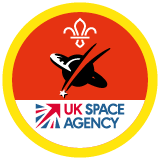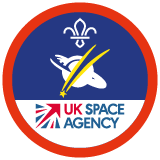
Cosmic kingdom
You’ll need
- Pens or pencils
- Stickers in nine different colours, or sticky labels
- Craft materials, including paper, string and chalk (optional)
- Nine different-sized balls or ball-shaped items (optional)
Think about the solar system we live in, it’s so vast that it takes years for spacecrafts to reach the furthest point. We have the sun, eight planets and one dwarf planet plus a variety of moons and distant stars that make our skies light up at night. This game will help put into perspective how big our solar system is by working as a group to map the planets on a picture of the United Kingdom.
Before you begin
- Print copies of a map of the UK for each group. Make these as large as possible.
- Find stickers in nine different colours. Think about using different colours for each planet or having a colour for each group. Also consider using white stickers and getting everybody to draw their planets before sticking them on.
Planet discovery
- Everyone should split into groups of no more than four. Give each group a map of the UK and their stickers or labels.
- See who can name the one star and nine (named) planets and dwarf planets in our solar system. Find out if anyone knows what order they’re in, from innermost to outermost.
The correct order is Sun, Mercury, Venus, Earth, Mars, Jupiter, Saturn, Uranus, Neptune, Pluto.
- Everyone should use their blank map of the UK to demonstrate which planet goes where. Start by placing the ‘Sun’ sticker at Land’s End, the south-westernmost tip of the UK. Check that everyone’s done this.
- Now, place the remaining planet stickers on the map, where they go in relation to the sun and each other. If your groups are drawing pictures of the planets on labels, give them an extra few minutes (and pens and pencils) to do this. Everyone should have ten minutes to place all their stickers.
- Check that groups work together to decide where their stickers should go. Encourage everyone to think before they stick, as some planets are more distant than others.
- When all of the stickers are on all of the maps, everyone should sit in a line in their groups and put their maps out in front of them. Compare the maps. See if anyone has put their stickers in different orders, or different distances apart.
- Show everyone the 'Mapping out the answers' image attached, so they can see which planet and dwarf planet should go where.
Enjoyed that? Take it further with...
Planetary mission
- Create a big version of a map of the UK using paper, string or chalk on the floor of your meeting place.
This can be created by everyone and can also be done outside for more room if needed
- Using different sized activity balls, place them as the planets on the UK map.
Sun (Large inflatable ball), Mercury (Tennis ball), Venus (Cricket ball), Earth (Baseball), Mars (Golf ball), Jupiter (Beach ball), Saturn (Basketball), Uranus (Football), Neptune (Volleyball) and Pluto (Table tennis ball).
Reflection
The solar system we live in is so vast that it takes years for spacecraft to reach the furthest point. There is the sun, eight planets, one dwarf planet and a huge variety of moons, asteroids and distant stars that make our skies light up at night. This activity helps put into perspective how big our solar system is by working as a group to map the planets on a picture of the United Kingdom. How did you agree as a team which planet went where? Did you have a resident expert or was it harder to remember the order of the planets outward from the sun?
Safety
All activities must be safely managed. You must complete a thorough risk assessment and take appropriate steps to reduce risk. Use the safety checklist to help you plan and risk assess your activity. Always get approval for the activity, and have suitable supervision and an InTouch process.
Everyone could draw each planet on their sticky label before sticking it on the map. They’ll have to think about how large it is, what shape it is and whether it has rings.
Instead of the UK, you could use a map of the local area or a familiar city. Using a real map allows you to work out which planet should go by plotting distances. You could then walk the route of your solar system on a stargazing night hike.
Stickers may need to have different textures, as well as colours, so that they can be distinguished by everyone.
Make sure everyone has everything they need to complete the tasks in this activity. Bear this in mind when splitting off into groups.
All Scout activities should be inclusive and accessible.
Complete this activity with the younger members of the whole group and get everyone to teach them the scales and size of our solar system using everyday objects.
This activity and badge can count towards a CREST Award.
Allow young people to complete the research on the scales and distances of the planets in relation to the UK.

